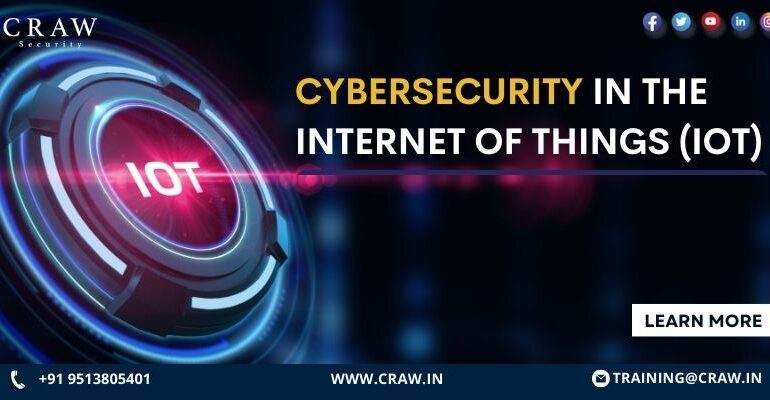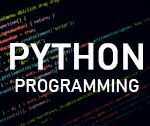Cybersecurity in the Internet of Things (IoT) | Craw Security

Cybersecurity in the Internet of Things (IoT) | Craw Security
Understanding the IoT Landscape
Gaining a comprehensive comprehension of the IoT (Internet of Things) environment is of paramount importance in contemporary times, given its rapid transformation of various sectors, economies, and daily routines. The fundamental concept of the Internet of Things (IoT) involves the integration of commonplace objects and gadgets with the Internet, allowing them to gather, share, and respond to data. In addition, the extensive network encompasses a wide array of gadgets, including smart household appliances, wearable health devices, intricate industrial gear, and urban infrastructure.
Moreover, the IoT landscape exhibits a confluence of hardware components such as sensors and devices, software elements including data analytics and machine learning, and connectivity solutions encompassing network protocols and cloud services. The proliferation of connected devices has led to an increased prominence of difficulties pertaining to data security, interoperability, and scalability. Nevertheless, the Internet of Things (IoT) possesses significant potential to enhance operational effectiveness, introduce novel business frameworks, and enhance overall well-being. Consequently, comprehending the intricacies of IoT is imperative for both technology experts and the wider populace.
In this article, you will find highly credible information related to cybersecurity in the IoT landscape. Read more to know more.
The Vulnerabilities Within
- Diverse Device Ecosystem
The IoT ecosystem encompasses a wide array of devices, resulting in a multitude of operating systems, firmware, and protocols. The ecosystem can be characterized as a fragmented collection of systems due to the diverse security standards employed by various manufacturers for each device type. The presence of diversity might potentially give rise to a multitude of vulnerabilities. The absence of a consistent security standard across various devices enables hackers to leverage less secure devices as potential entry points to infiltrate the broader network. The presence of variety within devices further hampers the universal implementation of security updates or patches, resulting in certain devices remaining forever susceptible to vulnerabilities.
- Data Privacy Concerns
The issue of data privacy arises due to the continuous collection, transmission, and storage of data by Internet of Things (IoT) devices. Certain portions of the provided data possess personal and sensitive attributes, thereby unveiling discernible patterns pertaining to an individual’s daily regimen, well-being, or inclinations. In the event that Internet of Things (IoT) devices or their associated networks possess inadequate security measures, there exists a potential hazard wherein unauthorized entities may get access to the data in question. Furthermore, even when data is securely stored, the lack of clarity about how this data is utilized or shared by manufacturers or third-party groups can be a serious privacy risk.
- Limited Computing Resources
Numerous Internet of Things (IoT) devices are engineered with the objective of achieving cost-effectiveness and energy efficiency, resulting in inherent constraints on their processing capabilities and memory capacity. The presence of these limitations can provide difficulties in the successful implementation of comprehensive security protocols that necessitate increased processing resources. For instance, the use of comprehensive encryption techniques could potentially impose excessive demands on the computational resources of smaller devices. As a result, these devices may utilize less robust encryption or, in certain instances, lack encryption entirely. This constraint enhances their susceptibility to cyber-attacks and compromises data security.
The Pillars of IoT Cybersecurity
- Authentication and Authorization
The fundamental aspect of every secure system is its capacity to authenticate the identities of both devices and users consistently. Authentication is a process that verifies the identity of an entity, such as a user, device, or system, by confirming that it is indeed the entity it purports to be. After the process of authentication, the authorization mechanisms are responsible for determining the specific activities or data that the authenticated entity can access. By rigorously implementing authentication and authorization mechanisms, Internet of Things (IoT) systems may effectively mitigate the risk of illegal access and guarantee that only authorized entities are able to engage with the network.
- Encryption
Encryption serves as a cryptographic mechanism that functions as a code lock, effectively transforming data into an unintelligible form that remains inaccessible to anybody lacking the requisite decryption key. Through the implementation of encryption techniques, Internet of Things (IoT) systems can protect sensitive information from unauthorized access and eavesdropping both during data transmission and while the data is at rest. In the event of data packet interception during transmission, the encrypted data persists in a secure and incomprehensible state.
Regular Updates and Patch Management
The cyber realm is characterized by constant evolution since novel threats and weaknesses arise on a regular basis. In order to proactively mitigate potential security breaches, Internet of Things (IoT) devices must undergo periodic updates to their firmware and software, specifically designed to rectify identified vulnerabilities. A comprehensive patch management system guarantees that devices are consistently updated with the most recent security measures, thereby mitigating the risk of exposure to known vulnerabilities.
- Security by Design
Rather than implementing security measures as an afterthought, it is advisable to incorporate security considerations into the initial design of devices and systems. This idea involves the incorporation of security issues throughout all stages of product development, ranging from the initial concept through the final deployment. The use of this proactive strategy guarantees that security is not merely an external layer but rather an integral component thoroughly integrated inside the architecture and functioning of the device.
- Network Segmentation
The process of segmenting an Internet of Things (IoT) network allows for the isolation of different components inside the network. This implies that in the event of a vulnerability being exploited within a specific segment, the breach does not inherently provide unrestricted access to the entirety of the network. Network segmentation serves as a containment approach, effectively confining any possible harm inside a specific area and preventing uncontrolled propagation over the entire system. This feature not only improves the level of security but also facilitates the monitoring and management of network traffic.
Emerging Trends in IoT Security
| Machine Learning and AI | The utilization of machine learning and artificial intelligence is progressively pivotal in augmenting the security of the Internet of Things (IoT). These technologies enable systems to acquire knowledge from past data in order to identify abnormalities or atypical patterns in real time. For example, in the context of the Internet of Things (IoT), when a device initiates the transmission of data at an unusually high frequency or irregular intervals, artificial intelligence (AI) algorithms have the capability to detect such anomalous activity, thereby recognizing it as a potential security breach. Through the continuous process of adaptation and assimilation of novel data, these systems possess the capability to actively identify and address potential risks, frequently preempting any substantial harm that may ensue. |
| Blockchain Technology | Initially recognized for its involvement in the realm of digital currencies, blockchain technology is now being increasingly utilized in the domain of Internet of Things (IoT) security solutions. The decentralized nature of blockchain technology confers a notable resistance to tampering, hence safeguarding the integrity of data. Every transaction or data entry is documented as a block and connected to previous blocks, forming an unalterable chain. The aforementioned approach can be implemented in Internet of Things (IoT) devices in order to guarantee the integrity of data and mitigate the risk of unwanted alterations. Moreover, the utilization of blockchain technology can be applied to establish decentralized systems that are characterized by transparency and immutability, particularly in the context of device authentication and data transmission. |
| Zero Trust Security | The Zero Trust model is predicated on the core principle that all entities, regardless of their origin or affiliation with the organization, should not be granted inherent trust. The current shift in paradigm poses a challenge to the conventional practice of placing faith in devices and users within a network while maintaining a critical stance towards external organizations. In the realm of the Internet of Things (IoT), the implementation of a Zero Trust framework involves the ongoing verification of the authenticity and integrity of each device and network connection, irrespective of their geographical location or source. This implies that regardless of a device’s prior authentication, its activities and transactions undergo continuous verification, hence providing an extra level of security against any insider threats or compromised devices. |
FAQs Cybersecurity in the Internet of Things (IoT)
1: How vulnerable are IoT devices to cyberattacks?
IoT (Internet of Things) devices are notably vulnerable to cyberattacks for several reasons:
- Limited Hardware Capabilities,
- Lack of Security Updates,
- Diverse Ecosystem,
- Inadequate Security By Design,
- Default Credentials,
- Extended Lifespan,
- High Interconnectivity,
- Data Collection, etc.
2: Are there any industry standards for IoT cybersecurity?
There exist multiple industry standards and frameworks that are designed to tackle the cybersecurity concerns associated with Internet of Things (IoT) devices. Various organizations have recognized the significance and susceptibilities associated with the Internet of Things (IoT), leading them to create or currently develop standards that aim to provide guidance for manufacturers, developers, and users. Some noteworthy examples merit attention.
- ISO/IEC 27001,
- NIST (National Institute of Standards and Technology),
- IETF (Internet Engineering Task Force),
- GSMA,
- OWASP (Open Web Application Security Project),
- IoT Security Foundation (IoTSF),
- Industrial Internet Consortium (IIC),
- OneM2M, etc.
3: Can IoT devices be used for cyberattacks?
Absolutely, it has been observed that Internet of Things (IoT) devices have the potential to be utilized in cyberattacks, and instances of such exploitation have already been documented. The attractiveness of networked devices as targets for malicious actors is heightened by their vulnerabilities and the extensive scale on which they exist. The following are several instances in which Internet of Things (IoT) devices have been subjected to exploitation for the purpose of cyberattacks:
- Distributed Denial of Service (DDoS) Attacks,
- Botnets,
- Ransomware,
- Espionage and Surveillance,
- Pivot Attacks
- Data Theft,
- Cryptojacking, etc.
4: How can individuals protect their IoT devices?
Safeguarding Internet of Things (IoT) devices against cyber attacks necessitates the implementation of proactive measures and the maintenance of continuous vigilance. There are multiple measures that individuals can undertake to enhance the security of their Internet of Things (IoT) devices:
- Change Default Passwords,
- Regular Firmware Updates,
- Secure Your Network,
- Disable Unnecessary Features,
- Use Two-Factor Authentication,
- Review Device Settings,
- Purchase from Reputable Brands,
- Check for Security Features,
- Limit Remote Access,
- Stay Informed,
- Physically Secure Devices,
- Network Segmentation, etc.
5: What role does artificial intelligence (AI) play in IoT cybersecurity?
The role of Artificial Intelligence (AI) in augmenting cybersecurity for the Internet of Things (IoT) is becoming increasingly significant. The ability of this technology to efficiently process large volumes of data, identify trends, and make anticipatory judgments establishes it as a formidable asset for safeguarding Internet of Things (IoT) networks and devices. This paper discusses the contributions of artificial intelligence (AI) to the field of Internet of Things (IoT) cybersecurity:
- Anomaly Detection,
- Predictive Analysis,
- Phishing Detection,
- Automated Response,
- Optimized Security Protocols,
- Malware and Virus Detection,
- Scalability,
- Secure Communication, etc.
6: How can governments contribute to IoT cybersecurity?
The role of governments in assuring the security of Internet of Things (IoT) devices and ecosystems is of utmost importance. The scope of their impact extends across legislative frameworks, public-private partnerships, and direct action. This paper discusses the potential contributions of governments towards enhancing cybersecurity in the context of the Internet of Things (IoT):
- Legislation and Regulation,
- Certification Programs,
- Public Awareness Campaigns,
- Investment in Research
- Public-Private Partnerships
- Training and Education,
- Incident Response Frameworks,
- International Collaboration, and many more.
Wrapping Up
To wrap up, we would like to state that there are several factors that give genuine complements to Cybersecurity in the Internet of Things (IoT) devices. If a person has a high interest in starting a career in cybersecurity, then the same can choose the IoT Penetration Testing Course in India propagated by highly skilled training mentors of Craw Security, the Best Cybersecurity Training Institute in India.
To know more about the same, give a call at our hotline mobile number +91-951380501 and have a word with our immensely excelled educational consultants.















